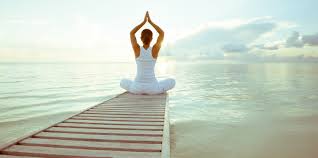In today’s fast-paced world, many individuals are seeking how do you meditate for a way to avoid everything and relax.
Mindfulness techniques, is essentially a method to obtain a level of deep thought and relaxation. It is one way to find inner peace and tranquility.
Many people consider monks or other spiritual types sitting in crossed-leg position and reaching states of bliss when they think of mediation.
But there are numerous ways to practice meditation that truly can save you.
Keep in mind that A Course in Miracles states: “Salvation is no more than a reminder this world is not your home.”
While how do you meditate covers many methods to reach a meditative state.
There truly are no right or wrong ways to moderate (this would defeat the purpose), only practice and finding ways that feel ideal for you.
Meditation is associated with numerous spiritual beliefs.
However one does not require to be associated with any specific religious beliefs in order to meditate.
Other forms of breathing meditation involve focusing on a visual image, such as a flame as a sign or a candle light.
No matter what the approach, the tools for how do you meditate assist users reach a state of mental relaxation.
I like to suggest this 7 Minute Mindfulness technique, a great way to learn how to do mindfulness meditation.
Lots of mediation methods help you clear your mind of the consistent ideas that generally run through the mind.
In reducing or getting rid of these thoughts, one can reach a state of reflection that is related to meditation.
There are a few primary approaches to meditation, which are reflective meditation and mindfulness meditation.
In mindfulness meditation, the practitioner sits quietly and “observes” everything in the environment. I mean, consisting of ideas, sounds, smells, and more.
In this type of meditation, the practitioner practices not responding to the environment (both external and internal). This is which can lead to a greater ability to act in a non-reactive way in day-to-day life.
Both mental and physical benefits can arise from meditation.
How do you meditate can consist of increased heart and lung health through relaxation. Likewise, reduced cholesterol and high blood pressure, and a more younger feeling.
Psychological advantages can be an increased sense of wellness, reduced anxiety and depression, and psychological stability.
Meditation only shouldn’t be used as a total treatment for physical or mental conditions. However, it can be a powerful supplement.
Those with physical or mental health conditions need to consult with a healthcare expert before beginning a mediation practice.
Meditation can be rather physical, such as with some kinds of yoga and meditation. Or relatively passive, such as in mindfulness types of mediation.
I like this yoga for weight-loss where many have found wonderful success with effective fat loss and metabolism burn.
In addition to how do you meditate there are different phases as well.
Usually speaking, in early stages of meditation, the professional is more familiar with the practice. She or he may have difficulty focusing on breath or not reacting to thought.
With practice, this moves into a phase where one is much less conscious.
This is followed by a phase of bliss, which is followed by extremely deep sense of self. As well, followed by an ability to reach a stage of deep stillness.
There are numerous resources readily available on meditation. When starting, those new to the practice might decide to take part in a class or guide.
Others may choose to check out the various choices and practice on his/her own. Visit the local library for books and resources or visit a yoga or spiritual master.
Meditation can provide and be a satisfying experience balance to an otherwise stressful life.
Meditation, which is basically an approach to acquire a level of deep perception and relaxation, is one method to find inner peace and serenity.
Next, let’s you and look at how to begin meditation with no experience.
How do you Meditate as a Beginner
Knowing by learning to be in the present moment is a good thought process to begin with.
Imagine thinking clearly, and sensations unwinding at will. Could you get more done? Enjoy life more? Would you like to understand how to do that right now?
Start by discovering how to put yourself more in the moment with a simple mindfulness exercise.
-
Basic Mindfulness Exercises
A basic mindfulness technique starts with sitting down, unwinding and breathing deeply.
Move your attention to your body, one part at a time, seeing any feelings of cold, hot, tight, sore or anything you can determine.
Open your eyes and look around as if seeing for the very first time. Continue this state of mindfulness till you’re all set to get up.
When sensing your body, your breath, and your immediate environments, you are more totally “in the moment.”
A mindfulness workout like this puts your mind in a receptive state while getting rid of mental interruptions that prevent clear thinking.
It leaves you ready to work psychologically on your passion and purpose for living in this world.
A Course in Miracles further states: “The Holy Spirit needs your special function, that His may be fulfilled. Think not you lack a special value here.
Do this before crucial pursuits toward your passion, and you’ll find you have more focus and concentration.
-
Using Mindfulness in Daily Life
Stop when you’re in the middle of a task and feel stressed. Take three deep breaths, then carefully view yourself up until recognizing what is bothering you.
Discover whatever you can. Are you expecting something bad to occur? Is an argument from today still going on simply below the surface of your awareness?
Are you fretted about something? Is some part of your body in pain? Keep in mind whatever you find.
Now handle these thieves-of-concentration one by one.
Make the telephone call that’s on your mind, take an aspirin if you need to, and apologize to someone if necessary.
Take things from your mind and put them on a list for tomorrow (in writing). If all you can do is acknowledge that there’s nothing you can do today – do that.
After doing this mindfulness workout, you’ll feel less stressed out, and you’ll have the ability to focus better on the jobs at hand.
Go ahead, try this out right now!
Start by discovering how to put yourself more in the moment with a simple mindfulness workout.
A fundamental mindfulness exercise begins with sitting down, relaxing and breathing deeply.
Continue this state of mindfulness until you’re prepared to get up.
A mindfulness exercise like this puts your mind in a responsive state while getting rid of mental diversions that impede clear thinking.
After doing this mindfulness workout, you’ll feel less stressed, and you’ll be able to focus more efficiently on the tasks at hand.
(Here’s another related article on yoga and meditation today more and more is helping people create the life they want and with peace of mind and happiness:)
In the next section, lets see how to reduce all the tension of a busy world by use of meditation.
How do you Meditate to Reduce Tension and Stress
Here you find a basic definition for how do you meditate, and an another easy meditation technique is described.
Meditation is a group of psychological training techniques.
You can use meditation to improve mental health and capacities, and likewise to assist enhance the physical health.
A few of these methods are extremely easy, so you can learn them from an article or a book; others need assistance by a certified meditation teacher.
A lot of techniques called meditation include these elements:
1. You sit or lie in a relaxed position.
2. You breathe regularly. You take in deep sufficient to get enough oxygen. When you breathe out, you relax your muscles so that your lungs are well cleared, but without straining.
3. You stop thinking about daily problems and matters.
4. You focus your thoughts upon some noise, some word you duplicate, some image, some abstract idea or some sensation. Your whole attention ought to be pointed at the item you have selected to concentrate upon.
5. If some foreign thoughts creep in, you simply stop this foreign idea, and return to the breathing of meditation.
The various meditation techniques differ according to the degree of concentration, and how foreign thoughts are handled.
By some strategies, the goal is to focus so extremely that no foreign thoughts take place at all.
In other techniques, the concentration is more relaxed so that foreign thoughts easily pop up.
When these foreign ideas are discovered, one stops these and goes back to the pure meditation in a tranquil way.
THE EFFECTS OF MEDITATION
How do you meditate has these effects:
1. Meditation will provide you rest and recreation.
2. You learn to relax.
3. You learn to concentrate much better on issue fixing.
4. Meditation typically has an excellent result upon the blood pressure.
5. Meditation has helpful impacts upon inner body processes, like respiration, digestion and blood circulation.
6. Regular meditation will have a psychotherapeutically effect.
7. Regular meditation will help with the immune system.
8. Meditation is typically enjoyable.
THE DIFFERENCE BETWEEN HYPNOSIS AND MEDITATION
Hypnosis might have some of the exact same relaxing and psychotherapeutic impacts as meditation.
However, when you meditate you are in control yourself; by hypnosis you let some mechanical device or some other individual control you.
Hypnosis will not have a training impact upon the capability to focus.
A SIMPLE FORM OF MEDITATION
Here is an easy form for how do you meditate.
By this meditation method, you must focus in a simple way.
1. Sit in an excellent chair in a comfy position.
2. Unwind all your muscles as well as you can.
3. Stop considering anything, or a minimum of try not to think of anything.
4. Breath out, relaxing all the muscles in your breathing apparatus.
5. Repeat the following in 10 – 20 minutes:
— Breath in so deep that you feel you get enough oxygen.
— Breath out, unwinding your chest and diaphragm completely.
— Every time you breathe out, believe the word “one” or another easy word inside yourself. You should think the word in an extended way, therefore that you hear it inside you, but you should try to prevent utilizing your mouth or voice.
6. If foreign ideas come in, just stop these thoughts in an unraveling manner. As well, keep on concentrating upon the breathing and the word you repeat.
As you proceed through this meditation, you must feel gradually more peaceful in your body and mind.
Yes, feel that you breathe gradually more effectively, which the blood circulation throughout your body gets more effective.
You might also feel an increasing psychological enjoyment throughout the meditation.
THE EFFECTS OF MEDITATION UPON DISEASES
As any kind of training, meditation might be overemphasized so that you get tired and worn out.
Therefore you need to not practice meditation so long or two concentrated that you feel tired or mentally emptied.
Meditation might in some cases give problems for people struggling with mental diseases, epilepsy, major heart issues or neurological illness.
On the other hand, meditation might be of assistance in the treatment of these and other conditions.
People experiencing such conditions must take a look at what results the different kinds of meditation have on their own sort of health problems.
Yes, before beginning to practice meditation, and beware if they pick to begin to practice meditation.
It might be a good idea to discover meditation from a skilled instructor, psychologist or health employee. One that utilizes meditation as a treatment module for the actual illness.
(Here’s an informative related article about the only expense you’ll have with benefits of daily meditation is a willingness and readiness to reach inwards.)
To a peaceful and happy life,
James Nussbaumer
PS: I invite you to sign up RIGHT HERE. Or in the footer below for the EVERYDAY MIRACLES newsletter. It’s where we (you the reader, and I, the author) bring our mind together for self-success.
PPS. Welcome to my website. Please feel free to tool around through the menu and see what others are discovering!
And for a better life.
See more at the Home page or About/Books on my ever-developing series for having a better life.
I write as reflections of A Course in Miracles. Or see the display at Ozark Mountain Publishing Co.
Please Support My Work through GoFundMe: Many have benefited from this material and we are offering you access to so much.
Visit the rest of my blog, self-help library, other articles. Also, webinars and lectures, and more, also for A Better Life Podcast.
By the way, if you’d like to get a copy of A Course in Miracles, hop over to the Self-Help Library page. 🙂
Thank you so much for your support!




